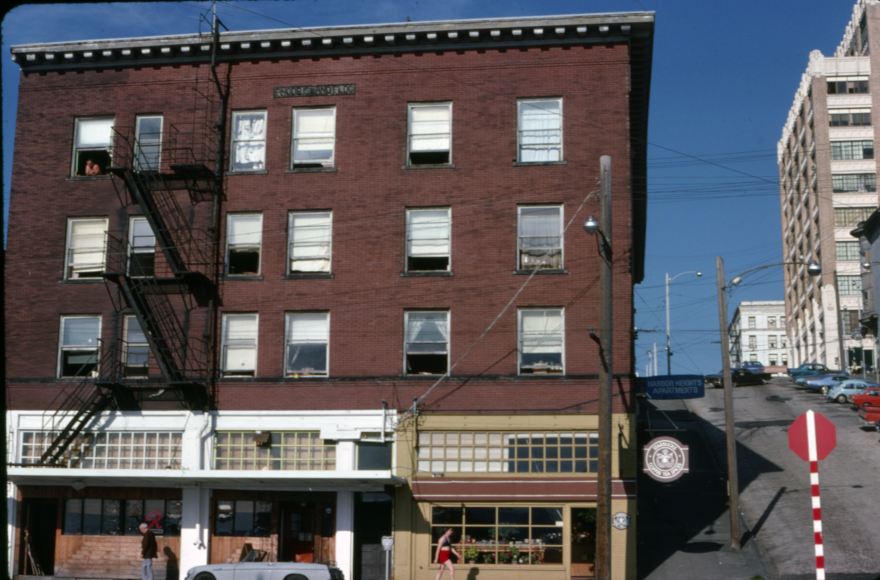Sometimes you play tour guide, leading visitors to Seattle's iconic sights. Or maybe it’s a day you feel inspired to explore your own city and region with a traveler’s eye. For either occasion, here are eight things you may not know about Pike Place Market.
1. Eye exams, dental cleanings and acupuncture are available
While the Market attracts an impressive amount of tourists, it's also a true Seattle neighborhood filled with residents, small businesses and public art.
Among the businesses there is an optometrist and dentist. There's also an acupuncturist who takes walk-ins.
2. Services for the Market community
While shopping and tourism abound, the Market is also a hub for social services including a preschool, community meal service, senior center, housing and more. In all, 10 nonprofits support the people who live and work in the Market, and even more in the nearby neighborhoods.
The Market Commons, a community resource center operated by the Pike Place Market Foundation, is a good starting point to learn more.
3. Did Obama or Godzilla pay for a tile?
Among the more than 50,000 tiles added to the Market floor, part of a fundraising campaign in the 1980s, are a few unexpected names: Barack Obama, Godzilla and Stephen Colbert.

In 2016, Seattle journalist Knute Berger investigated the Obama tile and did not find any record of the former president financially contributing to the renovation campaign.
One guess is that some tiles, especially those that might prompt a double take, have been added as sections of tiles have broken or been replaced.
Whether added later or not, these additions echo the Market’s celebrated spirit of chaos and how it serves as an intersection of politics and culture.
The Market Foundation provides an 1100-page tile catalog and a couple of maps so if you are seeking a tile, you can narrow down your search before beginning your quest.
4. A rooftop oasis
True to its name, the Pike Place Secret Garden is a hidden gem. Only a few steps away from the Market's lively hallways, it offers a more serene setting.

Located next to French restaurant Maximilien, the Secret Garden is also a working garden. Run by Market residents and staff, the produce grown there is donated to the nearby food bank.
Its rooftop location also offers the chance to peek out at Elliot Bay, see the Great Wheel in its rotations and monitor the Seattle waterfront’s gradual transformation from freeway to park.
5. Remembering the Japanese American farmers forced to leave
Across Seattle and the Pacific Northwest, the impact of Executive Order 9066 — which sent thousands of Japanese and Japanese Americans to incarceration camps during World War II — has been memorialized through monuments, art and music.

An art installation at Pike Place Market is a modest reminder of the Japanese Americans forced to leave the Market, their farms and their businesses. Before the order, 75% of Pike Place Market farmers were Japanese. Many never returned to the Market.
The mural “Song of the Earth” is located at the entrance below the iconic Public Market center clock and sign. Washington-based artist Aki Sogabe completed it in 1998 using kirie, a Japanese paper cutting technique.
Five poignant panels depict Japanese immigrants and their descendants in familiar scenes from the Pacific Northwest: logging, farming, selling produce at the Market and viewing Mt. Rainier.
6. A century of being bookish
In 1922, a Seattle Public Library branch opened on a lower floor of the Market known as “down under.” Although it closed in 1926, the literary tradition continues with Folio, a membership-based library, and half a dozen independent bookstores.
BLMF Literary Saloon owner J.B. Johnson told KNKX in a recent interview that being an independent bookseller isn’t an easy job, but there’s nothing else he’d rather do.
The Market has also inspired its fair share of literature from the 1929 textbook Markets: Public and Private to romance novels.

7. Is it really the original Starbucks?
Once upon a time, a building in Seattle was demolished to make way for a new one. As a result, some of the building’s tenants had to relocate — a familiar story in an ever-changing urban landscape. That building was the Rhode Island building and the tenant was a young Starbucks.
Around 1976, the five-year-old coffee roaster relocated from just north of Pike Place Market to a building at 1912 Pike Place. This move, from less than a block away, is why people may mutter “it’s not even the first Starbucks” as they walk around the almost constant line out front.
That second location is the one the company touts as “the first Starbucks store” — which is true if you separate the store from the location. It is undeniably, the oldest Starbucks.
8. The bronze piggy banks raise big bucks
The life-size bronze pigs, named Rachel and Billie, are more than a photo opp. Each year these piggy banks raise around $20,000 for the Pike Place Market Foundation and the social services (see #2) the foundation supports.
Bonus: You can be your own tour guide
There's a lot to see simply wandering around Pike Place Market. However, if you are interested in going deeper on your own time, try these self-guided tours about Market eateries or its architecture.
Developed by HistoryLink, an online encyclopedia of Washington state history, the tours can be read or listened to while visiting more than a dozen stops, all within walking distance.
What did we miss?
Veterans of the Market say there's always more to discover. Let us know about an unsung corner, story or program at Pike Place Market we missed by emailing outreach@knkx.org.
KNKX Connects is an ongoing series showcasing the people and places of our diverse and vibrant region. Your support helps KNKX connect listeners throughout Western Washington, presenting a much deeper look at the place we call home. Donate to this vital community service today.








